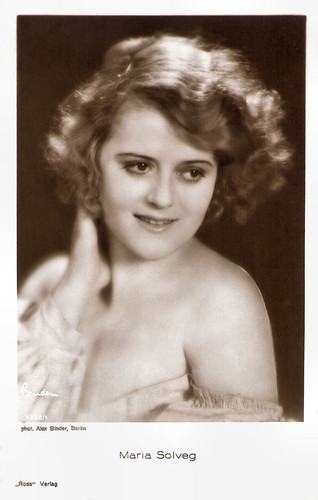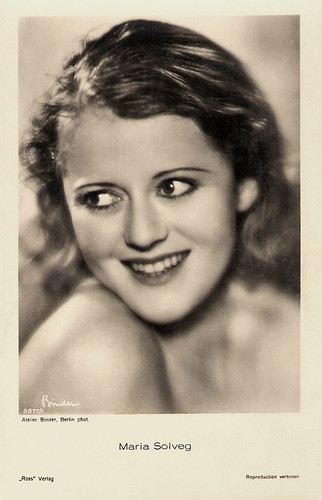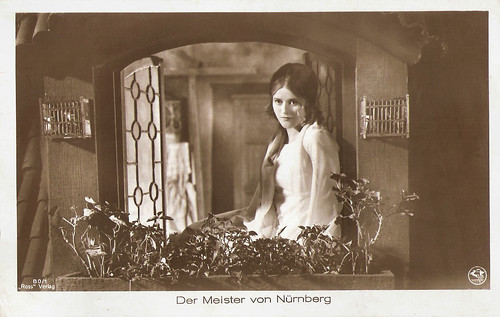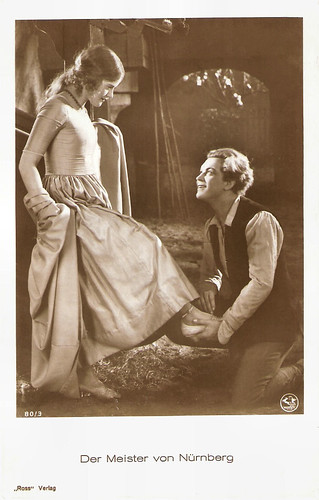
German postcard by Ross Verlag, no. 3362/1, 1928-1929. Photo: Alex Binder, Berlin.

German postcard by Ross Verlag, no. 5877/1, 1930-1931. Photo: Atelier Binder, Berlin.
The typical modern girl
Maria Solveg was born as Maria Stern in Niederschönhausen German Empire (now a part of Berlin, Germany), in 1907. Her aunt was German artist Käthe Kollwitz. Two of her older sisters were the actresses Johanna Hofer and Regula Keller, and the third was the dancer Katta Sterna.
Maria studied ballet as a child. At age 14, she left school and joined actor-director Ernst Matray's theatrical tour.
She began appearing in German films at 16. She made her film debut as Maria Solveg in the Austrian silent film Der letzte Deutschmeister/The Last German master (Johann Leopold Pock, 1923).
As the typical modern girl, Maria soon became a star of late Weimar cinema. She co-starred with Ernst Matray in Die wunderlichen Geschichten des Theodor Huber/The whimsical stories of Theodore Huber (Richard Löwenbein, 1924).
In 1927 she played the female lead in the silent historical comedy Der Meister von Nürnberg/The Master of Nuremberg (Ludwig Berger, 1927) starring Rudolf Rittner, Max Gülstorff and Gustav Fröhlich. The film is based on the opera Die Meistersinger von Nürnberg (1868) by Richard Wagner. According to Wikipedia, it was considered artistically unsuccessful because of its overly theatrical presentation.
While touring America in 1927, she married Matray. She developed into a fine choreographer and worked with Austrian theatre director Max Reinhardt. As a film actress she continued to be credited as Maria Solveg and smoothly made the transition to sound film.
In the mystery romance Der Sohn des weißen Berges/The Son of the White Mountain (Mario Bonnard, Luis Trenker, 1930) she co-starred with Trenker and Renate Müller. The film was part of the popular series of Mountain films of the era.
It was followed by the musical Ich glaub nie mehr an eine Frau/Never Trust a Woman (Max Reichmann, 1930) starring Richard Tauber, Paul Hörbiger and Werner Fuetterer, and the historical biopic Elisabeth von Österreich/Elisabeth of Austria (Adolf Trotz, 1931) featuring Lil Dagover as Empress Elisabeth of Austria.
Later films included the crime film Der Weg nach Rio/Road to Rio (Manfred Noa, 1931) also with Oskar Homolka and Oskar Marion, and the Harry Piel vehicle Der Geheimagent/The Secret Agent (Harry Piel, 1932).
A success was Der Hexer/The Sorceror (Martin Frič, Karel Lamač, 1932) a screen adaptation of Edgar Wallace's thriller The Ringer. She played the female lead opposite Paul Richter and Fritz Rasp.
Sadly, she then appeared in only one more film, Ein Mann mit Herz/A man with heart (Géza von Bolváry, 1932) opposite Gustav Fröhlich.

German postcard by Ross Verlag, no. 80/1. Photo: Phoebus-Film, Berlin. Publicity still for Der Meister von Nürnberg/The Master of Nuremberg (Ludwig Berger, 1927).

German postcard by Ross Verlag, no. 80/3. Photo: Phoebus-Film, Berlin. Publicity still for Der Meister von Nürnberg/The Master of Nuremberg (Ludwig Berger, 1927) with Gustav Fröhlich. Collection: Egbert Barten.
In exile
Following the Nazi takeover in 1933, the Jewish Maria Matray went into exile with her husband – initially in France and Britain before moving on the United States.
She couldn’t find jobs as an actress, but in 1938 she became the assistant of Max Reinhardt for the stage production of Faust in Los Angeles and San Francisco.
In Hollywood, she developed a new career as a choreographer and writer, as Maria Matray. Together with her husband, she choreographed several Hollywood movies, often without a screen credit, most notably White Cargo (Richard Thorpe, 1942), Swing Fever (Tim Whelan, 1943), and The Private Affairs of Bel Ami (Albert Lewin, 1947).
One of her stories as adapted for the musical mystery Murder in the Music Hall (John English, 1946) starring Vera Ralston. It involves a murder in Radio City Music Hall with The Rockettes as suspects.
She also wrote the screenplay for the TV film The Last Act (William Asher, 1952), an episode of Invitation Playhouse: Mind Over Murder.
The Matrays moved back to Germany in 1953. For television, she wrote screenplays for Der König mit dem Regenschirm/The king with the umbrella (Ernst Matray, 1954), and Abschiedsvorstellung/Farewell performance (Ernst Matray, 1955), with Elfie Mayerhofer.
She and Ernest Matray then separated and they officially divorced in 1962. Maria began writing novels and scripts for television with her new partner, Answald Krüger.
They also worked for the cinema and wrote screenplays for Mein Vater, der Schauspieler/My father, the actor (Robert Siodmak 1956) featuring O.W. Fischer, Wie ein Sturmwind/Tempestuous Love (Falk Harnack, 1957) starring Lilli Palmer, and the musical ...und abends in die Scala/An evening at the Scala (Erik Ode, 1958) with Caterina Valente.
The best known of these films is probably Die schöne Lügnerin/The beautiful liar (Axel von Ambesser, 1959) starring Romy Schneider and Jean-Claude Pascal.
She continued writing scripts with Krüger until his death in 1977. One of their later scripts was for Maximilian von Mexiko/Maximilan of Mexico (Günter Gräwert, 1970), a German-Austrian historical television miniseries depicting the events of the French Intervention in Mexico which placed Emperor Maximilian on the throne of Mexico.
Later, she worked with different authors. Maria Matray continued to write TV screenplays till her death in 1993 in Munich, Germany. She was 86.

German postcard by Ross Verlag, no. 4870/1, 1929-1930. Photo: Atelier Gudenberg, Berlin.

German postcard, no. 4064. Photo: Zander & Labisch.
Sources: C. Parker (Starlet Showcase), Film-Zeit.de (German), Wikipedia (German and English) and IMDb.
No comments:
Post a Comment